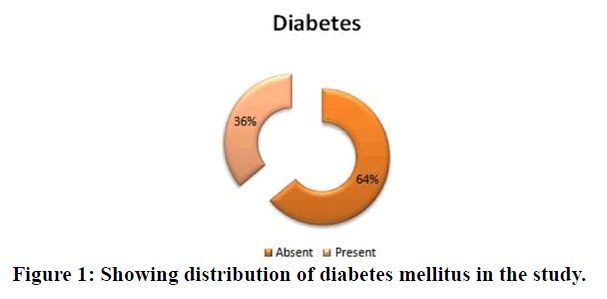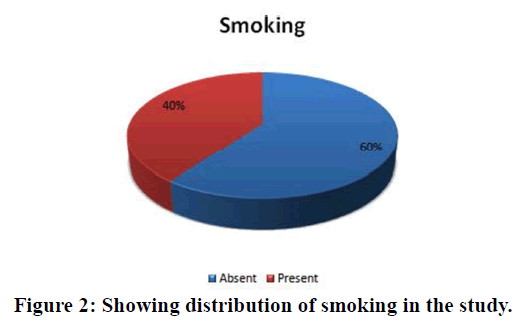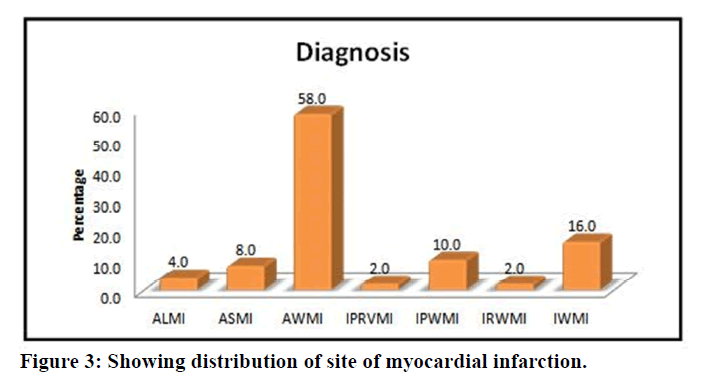Research - (2021) Volume 9, Issue 6
HyponatremiaâA Predictor of Short Term Mortality in Acute ST Segment Elevation Myocardial Infarction (STEMI)
Shweta Sureshbabu Saritha and K Shanmuganandan*
*Correspondence: K Shanmuganandan, Department of General Medicine, Sree Balaji Medical College & Hospital Affiliated to Bharath Institute of Higher Education and Research, India, Email:
Abstract
To study the prevalence of hyponatremia in a case of acute ST segment elevation myocardial infarction. To study the relationship between severity of hyponatremia and short term mortality. To determine the prognostic importance of hyponatremia in a case of acute ST segment elevation myocardial infarction. 50 patients admitted in the Intensive care unit of Sree Balaji Medical College and Hospital between November 2017 to July 2019, with acute ST segment elevation myocardial infarction (STEMI) were included in this prospective study Along with other risk factors, hyponatremia on admission or early development of hyponatremia appeared to be a significant independent risk factor in predicting short term mortality in acute myocardial infarction.
Keywords
Htponatremia, Cardiac failure, Cirrhosis, Diabetes
Introduction
The leading cause of death worldwide is coronary artery disease [1]. In 2015 coronary artery disease accounted for 72 million deaths worldwide [2,3]. 80% of which were in low income countries like India [4]. It has been estimated that by 2020, 2.6 million Indians are predicted to die because to coronary artery disease [5]. Indians are prone to get coronary artery disease at an earlier age compared to people in developed countries because of the high prevalence of risk factors like diabetes and hypertension [6,7]. ST segment elevation myocardial infarction is most common type of acute coronary event contributing 60.6% of overall incidence of acute coronary syndrome in Indian population8. The overall mortality in STEMI is approximately 4 to 7 % in the published clinical trials [8].
However this is not the case in the real world situation [9,10]. This is because the patients enrolled in the randomized trials are selected ones and represented lowrisk subgroup. Therefore the results of these trials are not applicable to 50% of patients in clinical practice [11]. A realistic view can be obtained from registry data.
In India, CREATE registry data recorded an in- hospital mortality rate of 7.9% and 30 day mortality rate of about 8.6%, which included both patients with unstable angina and AMI. Jacob et al. from Vellore (Tamilnadu), observed 16.9% in hospital mortality amongst the South Indian population following STEMI [12]. Hyponatremia is commonly seen amongst hospitalized patients [13-16] especially with comorbid conditions like cardiac failure, cirrhosis or nephrotic syndrome. Hyponatremia plays a major role in prediction of cardiovascular mortality amongst patients with cardiac failure [17-19]. The neurohormonal activation accompanying an acute myocardial infarction is similar to the one which accompanies a cardiac failure [20].
Hyponatremia is common after Myocardial infarction [21], and a rise in plasma sodium concentration accompanies clinical improvement in patients [22]. The prognostic importance of hyponatremia in a case of chronic heart failure is very well established whereas its importance acute myocardial infarction is lacking [23-30]. This study was conducted to determine the prognostic importance and usefulness of hyponatremia for predicting short term survival in a case of acute ST segment elevation MI.
Materials and Methods
50 patients admitted in the Intensive care unit of Sree Balaji Medical College and Hospital between November 2017 to July 2019, with acute ST segment elevation myocardial infarction (STEMI) was included in this prospective study.
Study design
Single centre and prospective.
Acute STEMI was diagnosed according to the following criteria:
Diagnosis of STEMI
• Presence of chest pain of >20min duration.
• ST segment elevation of >1mm in atleast two standard limb leads or >2mm in atleast two contiguous precordial leads or new onset of Left bundle Branch block.
• Elevated cardiac biomarkers.
Two out of Three criteria qualified for diagnosis of MI.
Inclusion criteria
Patients who presented within 12 hrs. of onset of symptoms STEMI included in the study.
Exclusion criteria
• Patients with Non STEMI or Unstable angina.
• Patients with previous history of coronary artery disease.
• Patients with previous history of arrhythmias.
• Patients with previous history of cardiomyopathy or heart failure.
• Patients with previous diuretic use.
• Patients with cirrhosis of liver, renal disease, hypothyroidism.
• Patients with Serum Creatinine >2mg%, Blood urea >60mg/dl.
Patients who fulfilled the above inclusion criteria and not having any of the above said exclusion criteria were included in the study as a participant.
Methods
12 lead ECG was taken for all patients, Leads V3R, V4R was taken in patients with inferior wall MI. Location of the infarct were defined as follow Anteroseptal MI: STsegment elevation in V1–V4 Apical MI: ST-segment elevation in V5–V6 Anterolateral MI: ST-segment elevation in LI, aVL,V4-V6 Extensive Anterior wall MI: STsegment elevation in LI, aVL, V1-V6 Inferior wall MI: STsegment elevation in LII, LIII, aVF Right ventricular MI: ST-segment elevation in V3R, V4R Posterior wall MI: Tall and wide R wave, depressed and concave upwards ST, upright and widened T wave in V2.
Statistical method
The collected data were analysed with IBM.SPSS statistics software 23.0 Version. To describe about the data descriptive statistics frequency analysis, percentage analysis were used for categorical variables and the mean & S.D were used for continuous variables. To find the significant difference between the bivariate samples in Independent groups the Unpaired sample t -test was used. To find the significance in categorical data Chi- Square test was used similarly if the expected cell frequency is less than 5 in 2×2 tables then the Fisher's Exact was used. In all the above statistical tools the probability value .05 is considered as significant level.
Results
Our Study population was 50 which included 40 male patients (80% of the study population were male) and 10 were female (20% of the study population were female) (Table 1). Our study population was 50 patients demographic distribution shows 18 patients have diabetes mellitus (36% of study population) and 32 patients were non-diabetic (64% of the study population) (Figure 1).
| Gender | Frequency | Percent |
|---|---|---|
| Female | 10 | 20 |
| Male | 40 | 80 |
| Total | 50 | 100 |
Table 1: Distribution of patients according to gender.

Figure 1. Showing distribution of diabetes mellitus in the study.
Our study population was 50, demographic distribution showed 21 patients as hypertensive (42% of the study population) and 29 patients were non-hypertensive (which includes 58% of the study population) (Table 2).
| HTN | |||
|---|---|---|---|
| Frequency | Percent | ||
| Valid | Absent | 29 | 58 |
| Present | 21 | 42 | |
| Total | 50 | 100 | |
Table 2: Showing distribution of hypertension amongst patients.
Our study population was 50 demographic distributions shows 20 patients as smokers (which includes 40% of the study population) and 30 were non-smokers (which includes 60% of the study population) (Figure 2).

Figure 2. Showing distribution of smoking in the study.
Our study population was 50 patients, 39 patients were Killip class I (which includes 78% of the study population) 9 patients were Killip class II (18% of the study population) and 2 patients were Killip class III (which includes 4% of the study population) (Table 3). Demographic distribution showing AWMI 58% most commonly involved followed by IWMI 16%, IPWMI 10%, ASMI 8%, ALMI 4%, PRVMI 2% and IRWMI 2% (Figure 3).
| Killip classification | ||
|---|---|---|
| Frequency | Percent | |
| I | 39 | 78 |
| II | 9 | 18 |
| III | 2 | 4 |
| Total | 50 | 100 |
Table 3: Showing distribution.

Figure 3. Showing distribution of site of myocardial infarction.
Discussion
In acute myocardial infarction the development of hyponatremia is a marker that probably incorporates different prognostic entities, including severe left ventricular dysfunction, hemodynamic alterations, and the extent of neurohormonal activation. Goldberg A et al [31] studied 1047 patients with acute ST elevation MI, without past history of heart failure. It was found that hyponatremia on admission or early development of hyponatremia was independently associated with short term mortality [26]. Our study comprised of 50 patients with acute ST elevation MI. The mean age was 52.7 ± 12.5. Majority of the cases were in the age group of 61 -70. In the study conducted by Aziz M et al, the mean age was 57.28±6. In Goldberg’s study the mean age was 61±12.When compared to the other studies it is seen that Indians are prone to get MI at an earlier age [31]
In our study, 80% were males and 20% were females. Similar results were seen in a studies conducted by Goldberg et al. [31]. Thus males are more prone to develop MI. In our study 20 patients were smokers, 21 were hypertensive and 18 were diabetic. Which accounts for 40% were smokers, 42% were hypertensive, 36% were diabetic [27]. Framingham heart study said that diabetes and smoking increases the risk of death after myocardial infarction. In GISS-2 trial 69, out of 11483 hypertensive MI patients, 3306 patients expired. Our study reveals that Diabetes, Hypertension and smoking are important risk factors in determining mortality. In our study, hyponatremia was present on admission in 14 patients .In a study conducted by Goldberg et al, [31] hyponatremia was present in 131 patients (12.5%) and hyponatremia developed in 208(19.9%) during the first 72 hours of hospitalisation. Similar results were seen in the studies conducted by Flear CT et al [22] and Schrier et al. [28] our results were also consistant with other studies.
Patients who presented with hyponatremia on admission belonged to a higher age (54 ± 14) when compared to patients with normal sodium levels who belonged to younger age (50 ±12). In the study conducted by Goldberg et al. [31] and Hammerman et al. [32] mean age among patients with normal sodium levels was 61±13 and hyponatremic individuals was 63±13. Males constituted majority of the cases [29,30]. There were 30 male (83.3%) with normal sodium levels, 10 male(71.4%) with hyponatremia on admission. There were 6 female with normal sodium levels, 4 with hyponatremia on admission. The higher male ratio was due to the fact that number of females were less in our study. Similar results were found in Goldberg A, Hammerman H et al, Aziz M et al “s study [31].
Among patients with normal sodium levels 27.8% were diabetic, 38.9% were smokers and 38.9% were hypertensive. In patients who presented with hyponatremia on admission 57.1% were diabetic,42.9% were smokers,50% were hypertensive. Thus hyponatremia was more common among smokers, diabetic and hypertensive individuals. This is in accordance to the studies conducted by Goldberg et al. [31] and Hammerman H et al [32].
Conclusion
Asians are prone to develop STEMI at a youger age than western population. In Indians hypertension, smoking, dyslipidemia, diabetes are predominant risk factors for STEMI. Hyponatremia on admission or early development of hyponatremia within 72 hours was associated with a poor prognostic outcome which had a mortality rate of 63.61%. Hyponatremia on admission with low ejection fraction showed a poor prognostic outcome.
Patients with hyponatremia were males belonging to a higher age group, with lower ejection fraction; anterior wall infarction and a higher proportion of them were smokers, hypertensive, diabetic and had dyslipidemia. Along with other risk factors, hyponatremia on admission or early development of hyponatremia appeared to be a significant independent risk factor in predicting short term mortality in acute myocardial infarction.
Funding
No funding sources.
Ethical Approval
The study was approved by the Institutional Ethics Committee.
Conflict of Interest
The authors declare no conflict of interest.
Acknowledegements
The encouragement and support from Bharath University, Chennai, is gratefully acknowledged. For provided the laboratory facilities to carry out the research work.
References
- Lopez AD, Mathers CD, Ezatti M, et al .Global and regional burden of disease and risk factors2001: Systematic analysis of population health data. Lancet 2006; 367:1747-57.
- Castelli WP. Epidemiology of coronary heart disease: The framingham study. Am J Med 1984; 27:4–12.
- Rogers WJ, Canto JG, Lambrew CT, et al. Temporal trends in the treatment of over 1.5 million patients with myocardial infarction in the US from 1990 through 1999: The national registry of myocardial infarction 1, 2 and 3. J Am College Cardiol 2000; 36:2056-63.
- Reddy KS, Cardiovascular disease in non-western countries. N Engl J Med 2004; 350:2438-40.
- Ghaffer A, Reddy KS, Singhi M. Burden of non-communicable diseases in South Asia. BMJ 2004; 328:807-10.
- Mohan V , Deepa R, Rani SS, et al. prevalence coronary artery disease and its relationship to lipids in selected population in South India. The Chennai urban population study (CUPS No 5). J Am Coll Cardiol 2001; 38:682-87.
- Joshi P, Islam S, Pais P, et al. Risk factors for early myocardial infarction in South Asians compared with individuals in other countries. JAMA 2007; 297:286-9.
- Pais P, Xavier D, Gupta R, et al. Treatment and outcome of acute coronary syndrome in India the (CREATE):A prospective analysis of registry data. Lancet 2008; 371:1435-42.
- Brown N, Young T, Gray D, et al. Inpatient deaths from acute myocardial infarction 1982-1992: Analysis of data in Nottingham heart attack register. BMJ 1997; 315:159-164.
- Every NR, Freiderick PD, Robinson M, et al. A comparison of the national registry of myocardial infarction -2 with the co-operative cardiovascular project. J Am Coll Cardiol 1999; 33:1886-94.
- ZeymerU, Senges J. Why do we need prospective registries in patients with myocardial infarction. Eu Heart J 2003; 24:1611-12.
- Jose VJ, Gupta SN. Mortality and morbidity of acute ST segment elevation myocardial infarction in the current era. Indian Heart J 2004; 56:210-4.
- Upadhyay A, Jaber BL, Madias NE. Incidence and prevalence of hyponatremia. Am J Med 2006; 119:S30-S35.
- Clayton JA, Le Jeune IR, Hall IP. Severe hyponatraemia in medical in patients: aetiology, assessment and outcome. QJM 2006; 99:505-511.
- Zilberberg MD, Exuzides A, Spalding J, et al. Epidemiology, clinical and economic outcomes of admission hyponatremia among hospitalized patients. Curr Med Res Opin 2008; 24:1601-1608.
- Chung HM, Kluge R, Schrier RW, et al. Postoperative hyponatremia. A prospective study. Arch Intern Med 1986; 146:333-336.
- Schrier RW, Abraham WT. Hormones and hemodynamics in heart failure. N Engl J Med 1999; 341:577-585.
- Lee WH, Packer M. Prognostic importance of serum sodium concentration and its modification by converting-enzyme inhibition in patients with severe chronic Hyponatremia. Circulation 1986; 73:257-267.
- Saxon LA, Stevenson WG, Middlekauff HR, et al. Predicting death from progressive heart failure secondary to ischemic or idiopathic dilated cardiomyopathy. Am J Cardiol 1993; 72:62-65.
- Sigurdsson A, Held P, Swedberg K. Short- and long- term neurohormonal activation following acute myocardial infarction. Am Heart J 1993; 126:1068-1076.
- Bogdan M, Nartowicz E. Magnesium, potassium and sodium in acute MI. Kardiol Pol 1993; 38:263-266.
- Flear CT, Hilton P. Hyponatremia and severity and outcome of myocardial infarction. BMJ 1979; 1:1242-1246.
- Oren RM. Hyponatremia in congestive heart failure.Am J Cardiol 2005; 95:2B-7B.
- Lee DS, Austin PC, Rouleau JL, et al. Predicting mortality among patients hospitalized for heart failure: Derivation and validation of a clinical model. JAMA 2003; 290:2581–2587.
- Klein L, O’Connor CM, Leimberger JD, et al. Lower serum sodium is associated with increased short-term mortality in hospitalized patients with worsening heart failure: Results from the outcomes of a prospective trial of intravenous milrinone for exacerbations of chronic heart failure (OPTIME-CHF) Study. Circulation 2005; 111:2454 -2460.
- Gazino JM. Global burden of cardiovascular disease. In: Zipes, Libby, Bonow, Braunwald. Brauwnwalds heart disease, a text book of cardiovascular medicine. 8th Edn. Philadelphia: Elsevier Saunders; 2008.
- Schaller MD, Nussberger J, Feihl F. Clinical and hemodynamic correlates of elevated plasma arginine vasopressin after acute myocardial infarction. Am J Cardiol 1987; 60:1178-1180.
- Schrier RW, Berl T, Anderson RJ. Osmotic and nonosmotic control of vasopressin release. Am J Physiol 1979; 236:321-332.
- Kannel WB, McGee DL. Diabetes and cardiovascular risk factors: The Framingham study. Circulation 1979; 59:8-13.
- Fresco C, Avanzini F, Bosi S, et al. Prognostic value of a history of hypertension in 11483 patients with acute myocardial infarction treated with thrombolysis. J Hypertension 1996; 14:743–75.
- Goldberg A, Hammerman H, Petcherski S, et al. Hyponatremia and long term mortality in survivors of acute ST elevation myocardial infarction. Arch Intern Med 2006; 166:781-786.
- Hammerman H, Hillis LD, Forman S, et al. Risk stratification before thrombolytic therapy in patients with acute myocardial infarction. The thrombolysis in myocardial infarction (TIMI) Phase I I.Co-Investigators. J Am Coll Cardiol 1990; 16:313–315.
Author Info
Shweta Sureshbabu Saritha and K Shanmuganandan*
Department of General Medicine, Sree Balaji Medical College & Hospital Affiliated to Bharath Institute of Higher Education and Research, IndiaCitation: Shweta Sureshbabu Saritha, K Shanmuganandan, Hyponatremia–A Predictor of Short Term Mortality in Acute ST Segment Elevation Myocardial Infarction (STEMI), J Res Med Dent Sci, 2021, 9(6): 301-305
Received: 01-Apr-2021 Accepted: 23-Jun-2021
